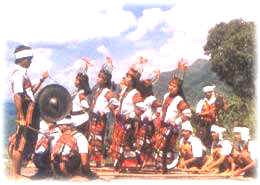
Dances

The Mizos, blessed as they are with a beautiful environment and rich culture, are
vibrant and sociable people. They love to dance as much as they love to sing.
They can boast of a number of folk and community dances which have been handed
down from one generation to the other through the ages. The dances are
expressions of the gay, carefree spirit of the Mizos.
Top
Cheraw :
Also known as " Bamboo
Dance ", for bamboos are used in this dance. The dancer moves by
stepping alternatively in and out from between and across a pair of horizontal
bamboos, held against the ground by people sitting face to face at either sides.
They tap the bamboos, open and close in rhythmic beats. The bamboos placed
horizontally, are supported by two bases, one at each end. The bamboos, when
clapped, produce a sharp sound which forms the rhythm of the dance. It indicates
the timing of the dance as well. The dancer steps in and out to the beats of the
bamboos with and grace. The patterns and stepping of the dance have many
variations. Sometimes the stepping are made in imitation of the movements of
birds, sometimes the swaying of trees, and so on.
Khuallam :
Khual, in the
Mizo language, means guest, and lam stands for dancing. So, Khuallam
is the dance of the guest. To have a place in paradise, one had to prove
one's mettle either in war or in hunting or by being a man of distinction in
society. To claim a distinguished place in society, one had to perform various
ceremonies which included offering community feasts and dances. These
ceremonies, taken together, were known as 'Khuangchawi'. While performing "Khuangchawi" one was obliged to invite relatives from nearby
villages. The guests entered the arena of the "Khuangchawi" dancing
Khuallam. The dance is normally performed by men dressed in 'Paundum'
(traditional Mizo clothes with red and green stripes) to the accompaniment of a
set of gongs known as Darbu.
Chheih Lam :
'Joie de vivre' would be
the appropriate term to describe 'Chheih Lam', a dance that embodies the
spirit of joy and exhilaration. Chheih Lam is performed to the
accompaniment of a song called Chheih hla. The song is sung to the
beats of a drum or bamboo tube or clapping of hands. People sqaut on the floor
in a circle while a dancer stands in the middle reciting a song with various
movements of limbs and body.
Top
Chai Lam :
Chai is a festival
dance. It is a community dance with men and women standing one after the another
in a circle, holding each other on the shoulder and the nape. The dancers sway
to and fro and swing their feet to the tune of the song sung in chorus by all of
them, while a drummer and a gongman beat their instruments. Horns and Mithuns
are other important instruments used in the dance. Legend has it that once they
started dancing, they did not know when to stop.
Rallu Lam :
Strictly speaking, Rallu Lam
is not a dance as such. It is rather a celebration or a rite in honour of a
victorious warrior. When a warrior comes back after a successful compaign, he is
given a warm and colourful reception by the village Chief. The celebration
consists of a re-enactment of the warrior's heroic exploits.
Solakia :
Originally, this dance was used
to be performed mainly by the people of the Maras and Pawi communities of
Mizoram. They remain the best exponents of the dance to date. Like Rallu Lam, Solakia
was also performed in earlier time to celebrate a victory in war. Marked with
five principal movements, the dance seeks to recapture the actions of a hero at
war.
Sarlamkai :
One of the most impressive Mizo
community dances, Sarlamkai is a variation of Solakia. The two
dances are almost identical. The only difference lies in the dress and tempo. No
song is sung; only gongs or cymbals or drums are used to beat time.
Par Lam :
The land of enchanting hills
has yet another dance to its credit - Par Lam. Girls attired in colourful
dresses, with flowers tucked in their hair, dance to the tune of songs sung by
themselves. The principal movement in the dance involves the waving of hands.
The most popular song sung for the dance : Far from the mountain the gay little
stream, rippling along, rippling along.
Top
|



